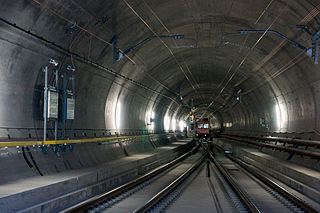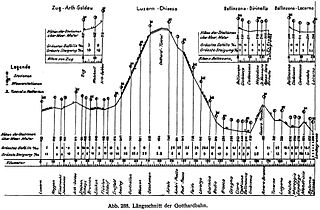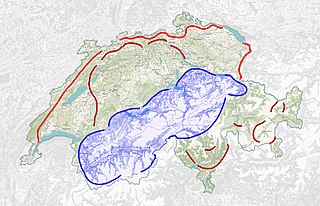
Switzerland has a dense network of roads and railways. The Swiss public transport network has a total length of 24,500 kilometres and has more than 2600 stations and stops.

Ticino, sometimes Tessin, officially the Republic and Canton of Ticino or less formally the Canton of Ticino, is one of the 26 cantons forming the Swiss Confederation. It is composed of eight districts and its capital city is Bellinzona. It is also traditionally divided into the Sopraceneri and the Sottoceneri, respectively north and south of Monte Ceneri.

The river Ticino is the most important perennial left-bank tributary of the Po. It has given its name to the Swiss canton through which its upper portion flows.

Rail transport in Switzerland is noteworthy for the density of its network, its coordination between services, its integration with other modes of transport, timeliness and a thriving domestic and trans-Alp freight system. It is made necessary by strong regulations on truck transport, and is enabled by properly coordinated intermodal logistics.

The Gotthard Base Tunnel is a railway tunnel through the Alps in Switzerland. It opened in June 2016 and full service began the following December. With a route length of 57.09 km (35.5 mi), it is the world's longest railway and deepest traffic tunnel and the first flat, low-level route through the Alps. It lies at the heart of the Gotthard axis and constitutes the third tunnel connecting the cantons of Uri and Ticino, after the Gotthard Tunnel and the Gotthard Road Tunnel.

Airolo is a municipality in the district of Leventina in the canton of Ticino in Switzerland.

The A13 is a motorway, at times an Autostrasse (expressway), which runs from St. Margrethen in northeastern Switzerland through to Ascona in southern Switzerland, crossing the main chain of the Alps in the Grisons area. It is the southern half of European route E43.

The San Bernardino road tunnel is a road tunnel in the canton of Graubünden in south-eastern Switzerland. It runs under the San Bernardino Pass between the town of San Bernardino and the town of Hinterrhein, and forms part of the A13 motorway and the European route E43. The tunnel was completed in 1967 and is 6,596 metres (21,640 ft) long. Since the opening of the tunnel, the Val Mesolcina, one of the Italian-speaking southern valleys of Graubünden, is now connected all-year round with the rest of the canton.

The A2 is a motorway in Switzerland. It forms Switzerland's main north–south axis from Basel to Chiasso, meandering with a slight drift toward the east. It lies on the Gotthard axis and crosses the Alps. Opened in 1955 under the name "Road Lucerne-south", A2 is one of the busiest motorways in Switzerland.

The Gotthard Pass or St. Gotthard Pass at 2,106 m (6,909 ft) is a mountain pass in the Alps traversing the Saint-Gotthard Massif and connecting northern Switzerland with southern Switzerland. The pass lies between Airolo in the Italian-speaking canton of Ticino, and Andermatt in the German-speaking canton of Uri, and connects further Bellinzona and Lugano to Lucerne, Basel, and Zürich. The Gotthard Pass lies at the heart of the Gotthard, a major transport axis of Europe, and it is crossed by three traffic tunnels, each being the world's longest at the time of their construction: the Gotthard Rail Tunnel (1882), the Gotthard Road Tunnel (1980) and the Gotthard Base Tunnel (2016). With the Lötschberg to the west, the Gotthard is one of the two main north-south routes through the Swiss Alps.

Andermatt is a mountain village and municipality in the canton of Uri in Switzerland. At an elevation of 1,437 meters (4,715 ft) above sea level, Andermatt is located at the center of the Saint-Gotthard Massif and the historical center cross of north-south and east-west traverses of Switzerland. It is some 28 km (17 mi) south of Altdorf, the capital of Uri.

Schöllenen Gorge is a gorge formed by the upper Reuss in the Swiss canton of Uri between the towns of Göschenen to the north and Andermatt to the south. It provides access to the St Gotthard Pass.

The Gotthard Tunnel is a 15-kilometre-long (9.3 mi) railway tunnel that forms the summit of the Gotthard Railway in Switzerland. It connects Göschenen with Airolo and was the first tunnel through the Saint-Gotthard Massif in order to bypass the St Gotthard Pass. It was built as single bore tunnel accommodating a standard gauge double-track railway throughout. When opened in 1882, the Gotthard Tunnel was the longest tunnel in the world.

The Gotthard railway, named after the Saint-Gotthard Massif which it crosses, is the Swiss trans-alpine railway line from northern Switzerland to the canton of Ticino. The line forms a major part of an important international railway link between northern and southern Europe, especially on the Rotterdam-Basel-Genoa corridor. The Gotthard Railway Company was the former private railway company that financed the construction of and originally operated that line.
Switzerland has a two-class highway system: motorways with separated roads for oncoming traffic and a standard maximal speed limit of 120 kilometres per hour (75 mph), and expressways often with oncoming traffic and a standard maximal speed limit of 100 kilometres per hour (62 mph).

The Ceneri Base Tunnel is a Swiss railway base tunnel in the canton of Ticino. It passes under Monte Ceneri between Camorino in the Magadino Flat and Vezia near Lugano; it bypasses the former high-altitude rail route through the Monte Ceneri Tunnel. It is composed of two single-track tunnels, each 15.4 km (9.6 mi) long. It is part of the New Railway Link through the Alps (NRLA) project for faster north-south rail links across the Swiss Alps.

Göschenen railway station is a railway station in the Swiss canton of Uri and municipality of Göschenen. Situated on the original line of the Gotthard railway, at the northern mouth of the Gotthard Tunnel, the station is also the junction point with the Schöllenenbahn. Most trains on the Gotthard route now use the Gotthard Base Tunnel and do not pass through Göschenen station.

The Swiss National Redoubt is a defensive plan developed by the Swiss government beginning in the 1880s to respond to foreign invasion. In the opening years of the Second World War the plan was expanded and refined to deal with a potential German invasion. The term "National Redoubt" primarily refers to the fortifications begun in the 1880s that secured the mountainous central part of Switzerland, providing a defended refuge for a retreating Swiss Army.

Airolo railway station is a railway station in the Swiss canton of Ticino and municipality of Airolo. The station is on the original line of the Swiss Federal Railways Gotthard railway, at the southern entrance to the Gotthard Tunnel. Most trains on the Gotthard route now use the Gotthard Base Tunnel and do not pass through Airolo station.

The border between the modern states of Switzerland and Italy extends for 744 kilometres (462 mi), from the French-Swiss-Italian tripoint at Mont Dolent in the west to the Austrian-Swiss-Italian tripoint near Piz Lad in the east. Much of the border runs across the High Alps, rising above 4,600 metres (15,100 ft) as it passes east of Dufourspitze, but it also descends to the lowest point in Switzerland as it passes Lago Maggiore at below 200 metres (660 ft).




















